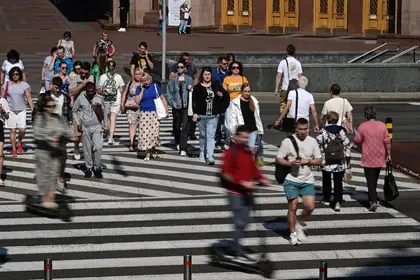“All wars have catastrophic effects on the population. But if there is no population, then there will be no state. The demographic crisis in Ukraine will continue to worsen.”
Such is the assessment of Oleksandr Gladun, Deputy Director for Science at the Ptukha Institute for Demography and Social Studies of the National Academy of Sciences of Ukraine, as he spoke to Kyiv Post.
JOIN US ON TELEGRAM
Follow our coverage of the war on the @Kyivpost_official.
The Ukrainian ethnic population is getting older every year, with each passing generation. Many factors account for this, but the most critical is a low birth rate.
The mass displacement of Ukrainians fleeing abroad because of Russia’s military aggression against Ukraine has also greatly affected the demographic crisis.
According to estimates of the Ptukha Institute for Demography, as of Jan. 1, 2022, some 36-37 million people lived in the territory of Ukraine, excluding occupied Crimea and the occupied areas of the Donetsk and Luhansk regions. If one were to include those temporarily occupied territories, the figure stood at 42 million people.
The Office of the United Nations High Commissioner for Refugees (UNHCR) reports that more than eight million Ukrainians have moved to European countries. Another 2.8 million live in Russia and Belarus. However, these numbers do not coincide with the data of Ukraine’s border guards and need to be clarified.
Since most of those who left are women and children, the demographic consequences are catastrophic, further deepening the nation’s aging problem in the future. Indeed, children under the age of 17 make up 35.4 percent of all those who have left Ukraine since the beginning of the full-scale war.

Zelensky’s Top General Syrsky Admits Ukraine’s Army Faces Challenges – But Says Fixes Are Coming
Many factors influence the number of Ukrainian citizens who will return from abroad after the war. According to the Institute, the primary factor will be the duration of the war. “This also concerns housing, the opportunity to get a job, social infrastructure. During the survey, a person may be determined to return but the real situation is such that there will be nowhere to return.” Ultimately, the Institute forecast that “the longer the war lasts, the fewer people will return.”
War is not the only cause
Even if there were no full-scale war, however, Ukraine would still be experiencing a demographic crisis.
“There was a crisis before, and it was gradually deepening. The war simply exacerbated everything,” Gladun says.
In the 2000s, significantly fewer Ukrainians were born than before. Now people from 18 to 25 years old are entering the reproductive period. Naturally, if there were fewer of them in the beginning, then they will reproduce fewer descendants.
Moreover, many people of this generation have emigrated abroad because of the war, many young people have sacrificed their lives for the motherland, and many simply do not dare create a family with children in such a difficult time.
Before the war, the reproduction rate in Ukraine was an average of 1.2 to 1.3 children per woman. That is slightly more than half of what is needed to maintain a steady population.
In order for the population not to decrease due to natural factors, Ukrainians need to give birth to an average of 2.1-2.2 children per woman.
“The war will also lead to the reduction of the birth rate, and it is clear that there will be an increase in mortality. In 2020, there were 210 deaths for every 100 births. In 2021, there were 263 deaths per 100 births. The coronavirus pandemic also significantly affected the numbers,” Gladun said.
High mortality, significant external and internal migration, poor health, and increasing poverty are additional social and economic challenges for the future of Ukraine. Any predictions require the formulation of hypotheses. So, when making the forecast, the Ptukha Institute for Demography had to make assumptions about the end of the war.
“We made a forecast for the population of Ukraine as a whole within the borders of 1991. We supposed that the war would finish at the end of 2024, possibly at the beginning of 2025. Considering this, we made a forecast for 15 years, until 2037. In 2037, there will be approximately 30 million people in Ukraine,” Gladun estimates.
What to do
Most European countries are going through a similar period in which the birth rate does not ensure maintaining the population, much less growth. But they carry out a certain demographic policy: namely, migration. What should Ukraine do in such a situation?
“It should either implement a migration policy or a plan to increase the birth rate. The state cannot function without the population. The authorities have now begun to deal with demography, although we have been talking about negative demographic processes for more than ten years. It took a war for all government structures to be interested in demography,” Gladun noted sadly.
For Ukraine not to lose its position on the world stage as a major European state, it is necessary to implement an active demographic policy. One of the first steps is to stabilize the population. That is, the state needs to make every effort to return Ukrainian women and children from abroad in the future. In order to stimulate the birth rate, there must be a real opportunity to provide housing, a decent salary and financial support for the birth of a second and especially a third child. But the most important thing is to end the war as soon as possible.
“The demographic situation in Ukraine is very dependent on the Armed Forces of Ukraine,” the demographer added. “The sooner they end the war, the more likely people will return.”
You can also highlight the text and press Ctrl + Enter










